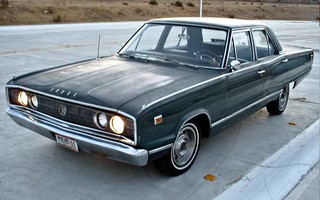 The crumpling of the Corvair was just one of several major events occurring within a few months time. Wreaking the Corvair led to purchasing another car and one of the other events led to purchasing a house. That event was my wife’s announcement that she was pregnant. We lived in a small one-bedroom apartment and immediately started looking for something larger. We looked at multi-bedroom apartments and a few rental houses. The owners of one house we looked at were considering renting as a last resort. They had already moved to a fancier place and were paying two mortgages. The financial strain coupled, I believe, with a little sympathy for the growing young family, resulted in them selling us the house on a land contract; a form of owner financing. So, in fairly short order, we became expectant parents, bought a three-bedroom house, and moved across town. Somewhere in there, we also bought a car.
The crumpling of the Corvair was just one of several major events occurring within a few months time. Wreaking the Corvair led to purchasing another car and one of the other events led to purchasing a house. That event was my wife’s announcement that she was pregnant. We lived in a small one-bedroom apartment and immediately started looking for something larger. We looked at multi-bedroom apartments and a few rental houses. The owners of one house we looked at were considering renting as a last resort. They had already moved to a fancier place and were paying two mortgages. The financial strain coupled, I believe, with a little sympathy for the growing young family, resulted in them selling us the house on a land contract; a form of owner financing. So, in fairly short order, we became expectant parents, bought a three-bedroom house, and moved across town. Somewhere in there, we also bought a car.
We bought the car at one of those shady looking lots that can be found lined up on certain streets in every city. That’s not our car in the picture. Some of the paint looks really dull on the car in the picture and that wasn’t the case with our car at all. Otherwise, it’s a pretty close match. The lot where we made our purchase wasn’t a “buy here, pay here” place but it was barely one step removed. I’m sure the lot owner and the guy from the finance company were good friends or maybe related. The Dodge Coronet was no more than two years old but had obviously just been retired from some sort of fleet work. I don’t remember the mileage but doubt it was accurate, anyway. Other than the 318 V8 and automatic transmission, the car was completely devoid of options; not even a radio. But the salesman was slick and the dark blue four-door did look the part of a family sedan for our developing family image. I hung an 8-track player under the empty dash and used the new car to bring our new son to our new house.
Here are a couple of stories involving this car.
Our house sat on a hillside with a small almost unusable garage in the back at the level of the walkout basement. The driveway sloped sharply beside the house. The normal parking spot was about even with the front of the house at the top of the slope. One night, at just about the same time as I heard my wife at the door, I heard a loud bang. Half joking, I said something about the car rolling. She was only part way through the door and, looking over her shoulder, assured me that the car was still there. We laughed and forgot about it — until morning. When I headed off to work, there was no car in the driveway. Most likely left in “Drive”. it had rolled down the slope and halfway over a low stone wall at the top of a steeper and longer slope. It took a tow truck with a long cable to winch the car from its perch atop the wall.
During the time we had the Dodge, I was in a band and occasionally towed a trailer full of equipment. That wasn’t at all good for the transmission which I’m sure wasn’t treated particularly kindly in its previous life. It eventually died and was sent off to some shade tree mechanic for a rebuild. It seems likely that what he did was swap in an oldie from a junkyard but the car once again became mobile and I was happy. Before long, however, the transmission started slipping again. This happened while I was visiting my friend John and he was pretty sure the problem was merely a clogged filter. After we pulled the pan off of the transmission, we realized we needed some technical information so we took out our smart phones and looked up the specifications for a ’67 Coronet. Actually we did the 1970 equivalent and drove to the library to copy some information from a Chilton auto repair manual. Before leaving, we placed the transmission pan on some trash cans beside John’s house. I’m sure our jaws really dropped when we got back from the library and realized that the trash man had come and gone in our absence. Our panic was short lived, however, as John’s wife pointed to the pan lying beside the door. The trash man had started to cart off the detached piece of my car then had second thoughts and knocked at the door to see if it might not really be part of the week’s trash. Saved from myself by another unnamed hero.
Previous Wheels: Chapter 10 — 1964 Corvair
Next Wheels: Chapter 12 — 1961 Falcon

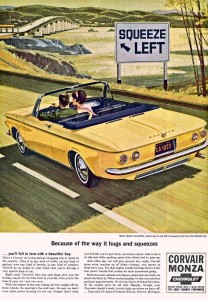
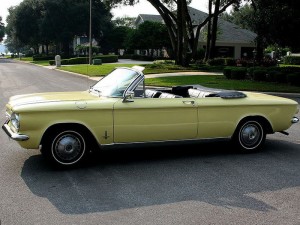

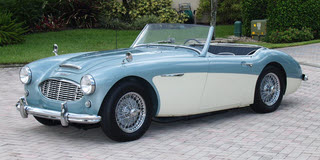 Why in the world would a couple of newly weds buy a ten year old British sports car in the middle of winter? I am, at present, as baffled as anyone though I apparently once knew the answer to that question. A month or so after our 1966 Boxing Day wedding, my bride and I purchased a 1957 Austin-Healey 100-6. The one pictured is a 1958 model but looks pretty much like our ’57. This was not a play car to park next to a dependable sedan. This was our only car.
Why in the world would a couple of newly weds buy a ten year old British sports car in the middle of winter? I am, at present, as baffled as anyone though I apparently once knew the answer to that question. A month or so after our 1966 Boxing Day wedding, my bride and I purchased a 1957 Austin-Healey 100-6. The one pictured is a 1958 model but looks pretty much like our ’57. This was not a play car to park next to a dependable sedan. This was our only car.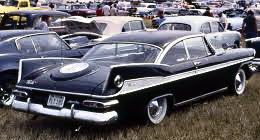 The 1959 Plymouth Fury at left is a dead ringer for the one I passed up to get the Austin-Healey. A rather spiffy ride, don’t you think? On one snowy night, my new wife and I were out with a friend in my borrowed car. The snow was not deep but the big Plymouth was not doing well on the slick streets. At one point, as we attempted to climb a slight incline, the friend and I got out to push while my wife took over driving. It did not take much to get the car moving but stopping to let us back in would have left the car stuck once again. Instead, my friend and I each grabbed a fin and “skied” alongside the Plymouth to the top of the hill.
The 1959 Plymouth Fury at left is a dead ringer for the one I passed up to get the Austin-Healey. A rather spiffy ride, don’t you think? On one snowy night, my new wife and I were out with a friend in my borrowed car. The snow was not deep but the big Plymouth was not doing well on the slick streets. At one point, as we attempted to climb a slight incline, the friend and I got out to push while my wife took over driving. It did not take much to get the car moving but stopping to let us back in would have left the car stuck once again. Instead, my friend and I each grabbed a fin and “skied” alongside the Plymouth to the top of the hill.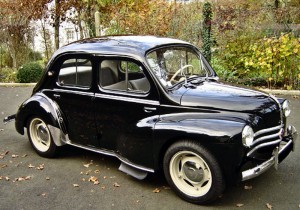

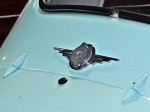
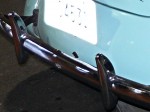
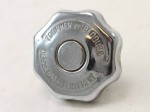
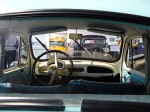
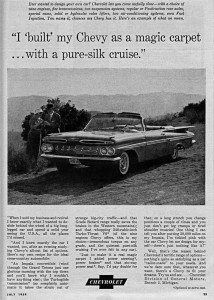
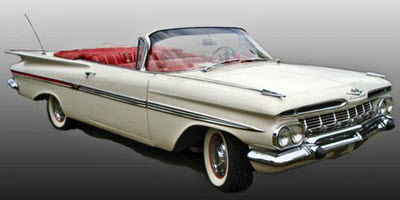 Getting back to my, I mean our, Chevy, you don’t have to imagine anything different from the car in the photo. That’s not our car but it could be. White with red interior and black top. 283 V8 with Powerglide automatic transmission. As we had planned, the car stayed with my sister while I lived in an on campus dormitory in Cincinnati — mostly. I did take the car with me for the last few weeks of the school year and I no doubt felt like one really cool dude. I don’t recall specific issues but the joint ownership thing came to an end that summer. For one thing, I decided I wanted a car with me for the next school year. I’m sure I didn’t have the money to buy out my sister and going with something that got a little better gas mileage seemed like a good idea. My sister became sole owner of the Impala but not its sole driver. I never did know all the details but there was at least one wreck when someone else was driving. I don’t believe the car was actually totaled but there was enough damage that the car went off to a new home.
Getting back to my, I mean our, Chevy, you don’t have to imagine anything different from the car in the photo. That’s not our car but it could be. White with red interior and black top. 283 V8 with Powerglide automatic transmission. As we had planned, the car stayed with my sister while I lived in an on campus dormitory in Cincinnati — mostly. I did take the car with me for the last few weeks of the school year and I no doubt felt like one really cool dude. I don’t recall specific issues but the joint ownership thing came to an end that summer. For one thing, I decided I wanted a car with me for the next school year. I’m sure I didn’t have the money to buy out my sister and going with something that got a little better gas mileage seemed like a good idea. My sister became sole owner of the Impala but not its sole driver. I never did know all the details but there was at least one wreck when someone else was driving. I don’t believe the car was actually totaled but there was enough damage that the car went off to a new home.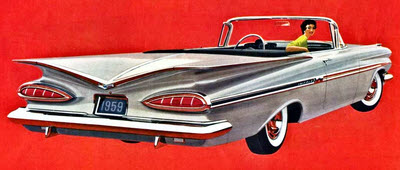 I’ve always liked this publicity picture. It emphasizes the car’s unique appearance and offers a hint at what it might be like in the front seat. I remember what it was like in the front seat. The hood was far from short — this was a full-size American cruiser — but it could seem that way by comparison with the rest of the car. With the top down, the view in the mirror was of a rear deck that reached to the horizon and extended all the way across it.
I’ve always liked this publicity picture. It emphasizes the car’s unique appearance and offers a hint at what it might be like in the front seat. I remember what it was like in the front seat. The hood was far from short — this was a full-size American cruiser — but it could seem that way by comparison with the rest of the car. With the top down, the view in the mirror was of a rear deck that reached to the horizon and extended all the way across it.
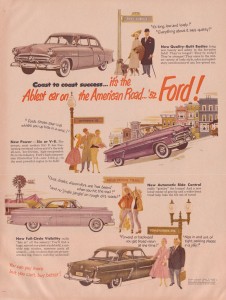
 Imagine the car in this picture with dark blue paint and baby moon hub caps and you’ll have something close to what I was driving in the spring of 1965. Besides two doors, it had dual two-barrels on an Offenhauser manifold, dual points in a Mallory distributor, and dual exhausts. It wasn’t particularly fast by 1965 standards but its description sounded fast.
Imagine the car in this picture with dark blue paint and baby moon hub caps and you’ll have something close to what I was driving in the spring of 1965. Besides two doors, it had dual two-barrels on an Offenhauser manifold, dual points in a Mallory distributor, and dual exhausts. It wasn’t particularly fast by 1965 standards but its description sounded fast.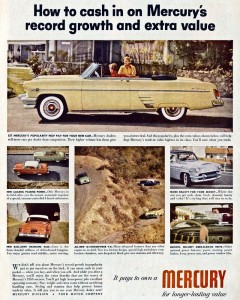
 When new, my car probably resembled the one at left. It never really did look all that bad and, unlike the Chevy before it, its engine just kept on going. But things were different underneath. I owned the car for less than a year and during that time the rear end lowered itself by a couple of inches due to rusting suspension. The floor pans had similar issues and the driver’s seat developed a noticeable rearward rake. I’m certain it was preparing to eject me downward at some point.
When new, my car probably resembled the one at left. It never really did look all that bad and, unlike the Chevy before it, its engine just kept on going. But things were different underneath. I owned the car for less than a year and during that time the rear end lowered itself by a couple of inches due to rusting suspension. The floor pans had similar issues and the driver’s seat developed a noticeable rearward rake. I’m certain it was preparing to eject me downward at some point.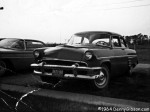
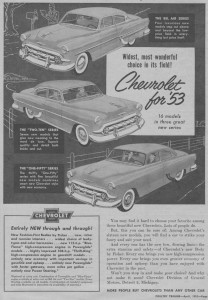
 My car was a green and white Bel Air that looked a lot like the car at left. Exceptions were that mine was a 4-door and it never looked nearly that shiny while I owned it. Late in the summer I threw a rod and did my first engine swap with something out of a wreck. During the winter, the front got a little wrinkled when I was intentionally doing donuts in the snow and unintentionally found a guard rail in my path. When the rods in my junkyard engine started knocking in the spring, the Chevy was done.
My car was a green and white Bel Air that looked a lot like the car at left. Exceptions were that mine was a 4-door and it never looked nearly that shiny while I owned it. Late in the summer I threw a rod and did my first engine swap with something out of a wreck. During the winter, the front got a little wrinkled when I was intentionally doing donuts in the snow and unintentionally found a guard rail in my path. When the rods in my junkyard engine started knocking in the spring, the Chevy was done.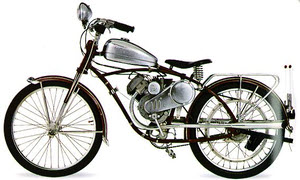 It was 1962, I was 15 years old, and I was going mobile. Fourteen and fifteen year old Ohioans can still ride two and three wheelers with “helper motors” but both vehicle and and rider require a license. Plus the motor must be under 50 CC and 1 HP and incapable of moving the rig faster than 20 MPH. Shish!
It was 1962, I was 15 years old, and I was going mobile. Fourteen and fifteen year old Ohioans can still ride two and three wheelers with “helper motors” but both vehicle and and rider require a license. Plus the motor must be under 50 CC and 1 HP and incapable of moving the rig faster than 20 MPH. Shish! Dale’s moped had a capital ‘M’ — and a hyphen. It was a real Mo-Ped sold by Sears under the Allstate brand. They were made, apparently, by Puch in Austria. Our two mopeds did the same job but they sure had their differences. The Mo-Ped had a two-cycle 50cc motor with a two speed transmission and chain drive. Power from the Whizzer’s larger four-cycle reached the rear wheel through a belt. Belts and pullies slip; Chains and gears don’t. Compared to the Whizzer, the Mo-Ped was a jackrabbit off the line. The Whizzer would slowly lumber into motion usually helped by my feet on the ground or on the pedals. The Whizzer’s top end was well above the Mo-Ped’s so I’d usually whiz by, to show I could, before settling down for a side by side cruise. When first setting out, the Mo-Ped could be started on its stand with a little pedal pushing. The Whizzer could, in theory, be started by pedaling but it was a real chore. The method of choice was to start pushing it, release the clutch, (‘pop’ is not a word often associated with the Whizzer belt idler.), and jump on after the bike started but before it ran away.
Dale’s moped had a capital ‘M’ — and a hyphen. It was a real Mo-Ped sold by Sears under the Allstate brand. They were made, apparently, by Puch in Austria. Our two mopeds did the same job but they sure had their differences. The Mo-Ped had a two-cycle 50cc motor with a two speed transmission and chain drive. Power from the Whizzer’s larger four-cycle reached the rear wheel through a belt. Belts and pullies slip; Chains and gears don’t. Compared to the Whizzer, the Mo-Ped was a jackrabbit off the line. The Whizzer would slowly lumber into motion usually helped by my feet on the ground or on the pedals. The Whizzer’s top end was well above the Mo-Ped’s so I’d usually whiz by, to show I could, before settling down for a side by side cruise. When first setting out, the Mo-Ped could be started on its stand with a little pedal pushing. The Whizzer could, in theory, be started by pedaling but it was a real chore. The method of choice was to start pushing it, release the clutch, (‘pop’ is not a word often associated with the Whizzer belt idler.), and jump on after the bike started but before it ran away.